10 July 2019, League of Ireland club Bohemians are playing host to Chelsea as part of The Blues pre-season campaign.
The game itself ends up being a non-occasion, it finishes a respectable 1-1.
In truth, it’s mainly about the newly appointed coach, Frank Lampard, giving some academy players a runout and of course, Bohs have enjoyed the opportunity to welcome Premier League opposition to Dalymount Park.
A slightly apprehensive looking 14 year old is introduced to the game as Bohs make a substitution in the 67th minute.
Within seconds of entering the fray, the nervousness lifts and it’s clear that this kid is born to be a footballer.
He appears so confident, wanting – no, demanding the ball in fact.
He looks to run at the Chelsea defence constantly.
He showcases intricate passes, cute little flicks around the corner to a teammate and a desire to battle for every ball.
Yes, it’s friendly and yes this is a teenager making his first team debut, and undoubtedly the adrenaline has taken over.
The talent though is undeniable.
Since that summer’s evening in the Irish capital, Lampard’s managerial career at Chelsea followed the path we all expected which ended with his rather predictable dismissal.
The somewhat worried looking 14 year old though, well, he has gone on to bigger and better things.
He made less than a handful of first-team appearances for Bohemians before Premier League club Brighton came calling.
Additionally, he’s now made his international debut and is regularly touted as the one who can carry the Republic of Ireland’s number 9 shirt for years to come.
So, who was that 14-year-old kid? Well, that was Evan Ferguson.
Now 18 years old and making a name for himself in English football’s top flight.
The Irish starlet decided to sign for Brighton’s academy in 2021 after opting to join the south coast club rather than Merseyside giants Liverpool.
Ferguson caught the eye of the Brighton hierarchy whilst playing for both the under-18s and under-23s.
After being carefully introduced to first-team football under Graham Potter, it is under current manager Roberto De Zerbi that the Irish forward has begun to thrive.
When any talented youngster breaks on the scene, clubs across the continent are sitting up and taking notice of this gem from the Emerald Isle.
Super-rich Newcastle United are the latest club linked with a recent scouting mission to Brighton.
It is thought Ferguson was the reason for said mission.
With the 18-year-old likely to become the subject of a bidding war in the summer and Brighton desperate to tie him to a long-term deal, here at Total Football Analysis, we thought that there is no better time to conduct an in-depth tactical analysis of Evan Ferguson’s all-round game.
This tactical analysis will take the form of a scout report where we will put the ‘four corner model’ to good use, in order for us to analyse the Irish international’s physical profile, technical abilities, tactical proficiencies and psychological tendencies.
We will also provide an analysis of how Ferguson fits into Brighton’s tactics and examine what clubs could be vying for his signature at the end of the season.
What does the data say?
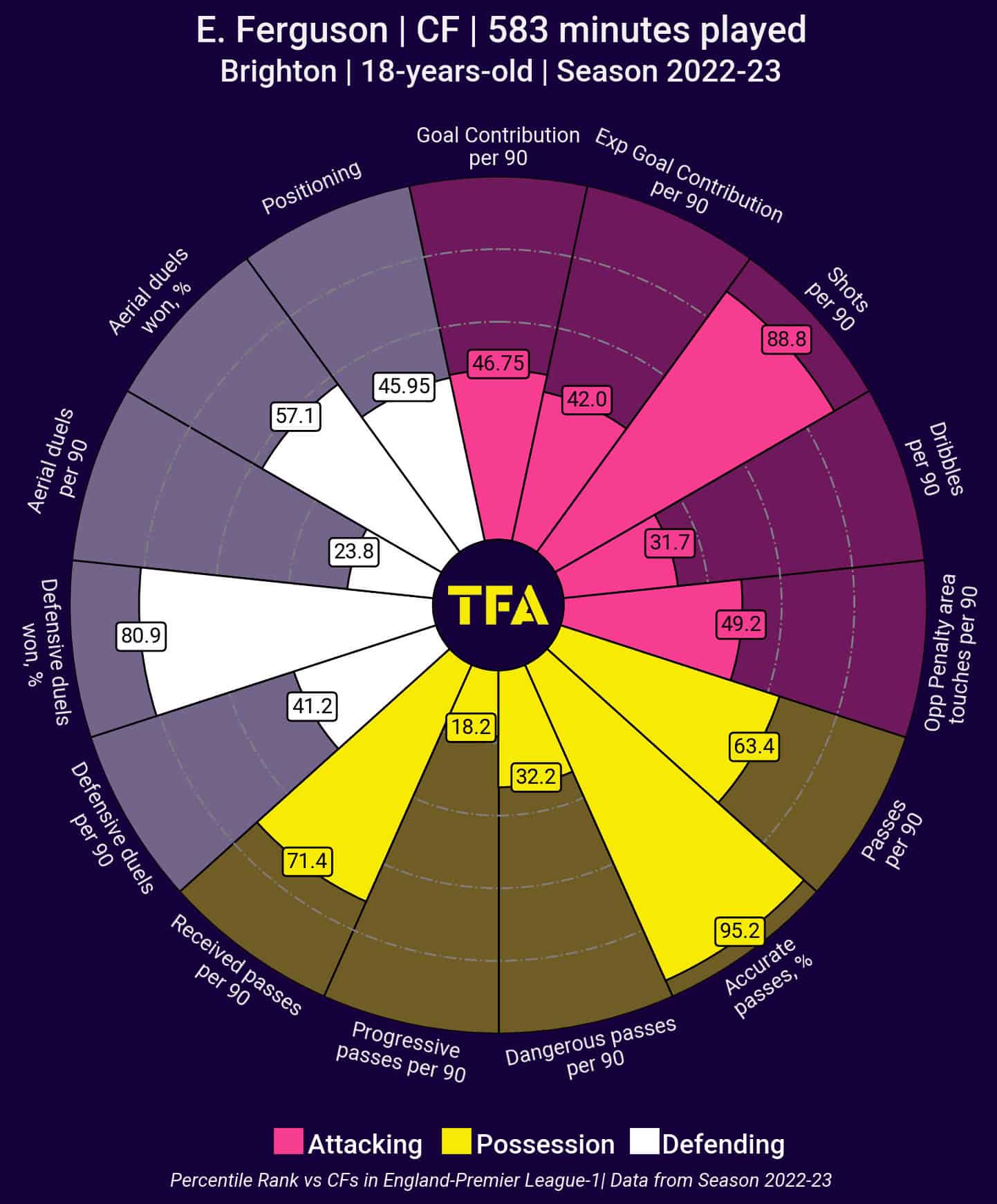
For
us to get a general overview of Ferguson’s style of play, the best place to begin this scout report is to look at what the numbers tell us.Data can help us paint a picture of the way a player behaves in the game and the areas in which they excel as well as where they require improvement.
Of course, it is all subjective based on how you interpret the data but it is incredibly useful to generate an approximate outline of a player’s style.
The pizza chart above shows us Evan Ferguson’s percentile rankings compared to his fellow centre forwards in the Premier League.
We can immediately see that he ranks very highly in terms of shots per 90, accurate passes and defensive duels won.
Based on this information, we can assume that the young Brighton forward is reliable in possession and his passes generally find their target.
His willingness to participate in duels indicates that he is tenacious and has a great desire to work for his team.
A link-up man
Standing at 188 cm tall, Ferguson’s physical profile is impressive for such a young player.
He is often able to hold the ball up and win duels with opponents as he possesses great physical strength.
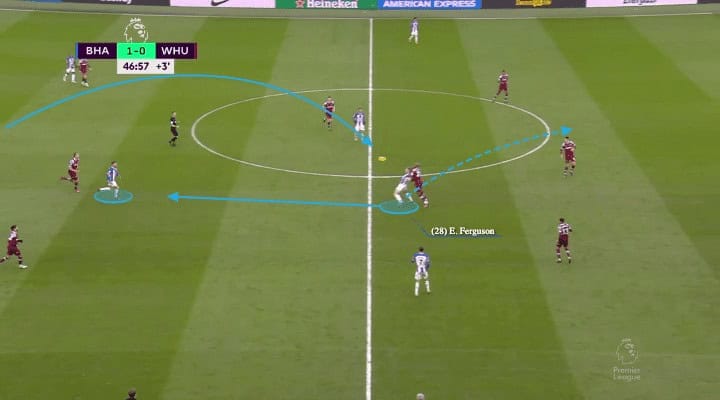
Ferguson’s strength is on display in Figure 1.1 where we can see a teammate has played a long ball forward to him.
He uses his physical strength to block the West Ham defender, all the while directing a chest pass back to another Brighton player.
He frequently demonstrates that despite his young age, he is more than capable of coping with the physical demands of the Premier League.
As the wonderful chest pass successfully lands at the feet of his teammate, Ferguson doesn’t rest on his laurels.
Instead, he spins his man and begins the charge forwards.
The centre forward also consistently shows that his physicality is linked to his footballing intelligence, Ferguson doesn’t simply go shoving opponents around, he is smart with it.
He is incredibly agile and able to adjust his body orientation very quickly and effectively which means defenders really struggle to cope with him in the penalty area.
His slick movements mean that the opponent has got to time their tackles to perfection or risk giving away a penalty.
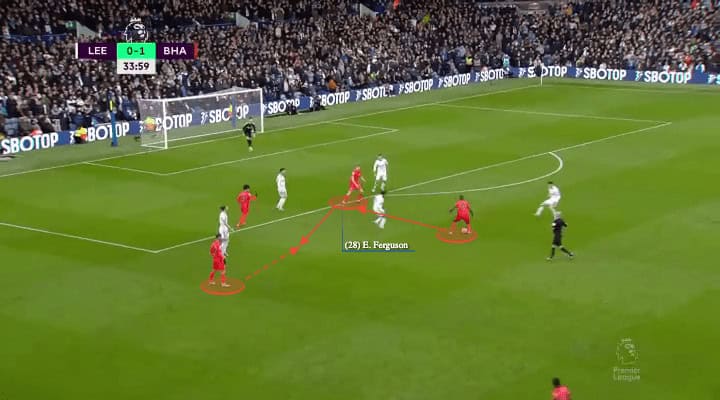
In this instance, we can see that Brighton are in the attacking phase and Ferguson is the subject of the Leeds defender’s attention.
Whilst the defenders focus on him, Ferguson makes the smart decision to quickly lay the ball off to a teammate and then spin into the penalty area.
As he does this, he takes two of the Leeds defenders with him, therefore he creates little pockets of space for fellow Brighton attackers.
Ball progression
If we move on to assess the talented centre forward’s technical abilities, the first thing that becomes apparent when watching him play is that under Robert De Zerbi, this Brighton team do not look to utilise Ferguson as someone who is going to consistently carry the ball forwards.
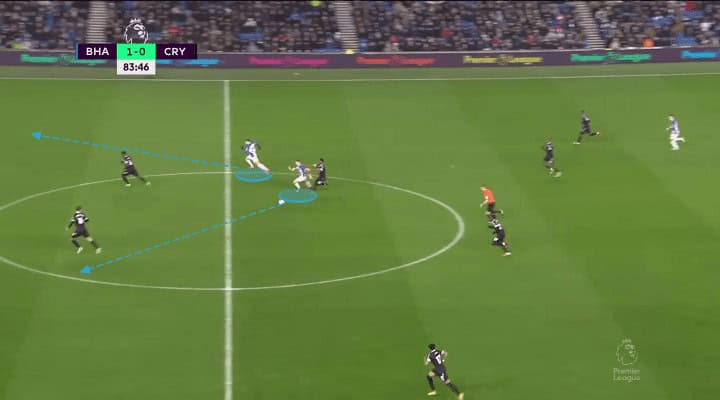
The only real occasion you will see Ferguson travel with the ball at his feet is when Brighton are looking to counterattack.
As we can see in Figure 2.1, due to his height, he goes back to provide additional defensive numbers at set pieces, as Brighton regains possession Evan Ferguson is carrying them up the pitch.
The youngster averages 1.85 dribbles per 90 and is successful in 33% of them so we can see that this is not an element of his game that De Zerbi looks to use very often.
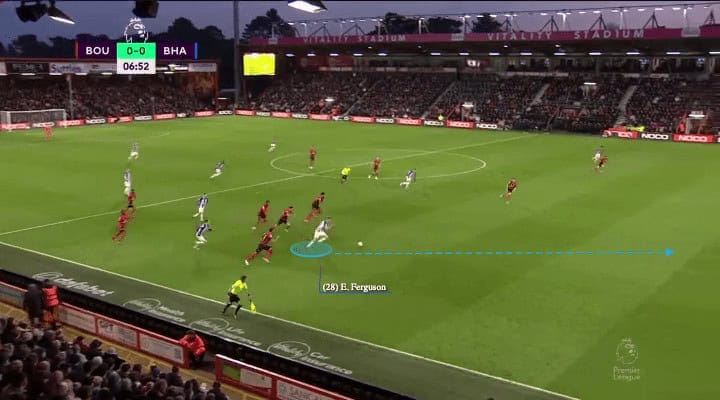
Here in Figure 2.2, taken from Brighton’s recent win against Bournemouth, admittedly Ferguson gets a little lucky with the bounce of the ball.
However, he displays a good turn of place while accelerating over short distances.
This allows him to carry the ball forward into the Bournemouth penalty area, presenting him with a 1v1 against the goalkeeper.
Picking a Pass
While a centre forward’s primary role is to score goals, they also need to be able to contribute to the team’s build-up play, which involves showcasing their passing capabilities.
Therefore, before we delve into Ferguson’s goal-scoring abilities, let’s take a look at his passing.
As we saw from the pizza chart, it is an area where he stood out in terms of accuracy.
A centre forward with good passing ability can create scoring opportunities for their teammates by setting them up with a well-placed and well-timed pass.
This can be especially important when the opposition has a structurally organised defence, and it’s difficult to get through them with individual dribbling or runs.
This is vital for good link-up play; in modern football, a forward needs to effectively connect with teammates in the attacking phase to create more goal-scoring opportunities.
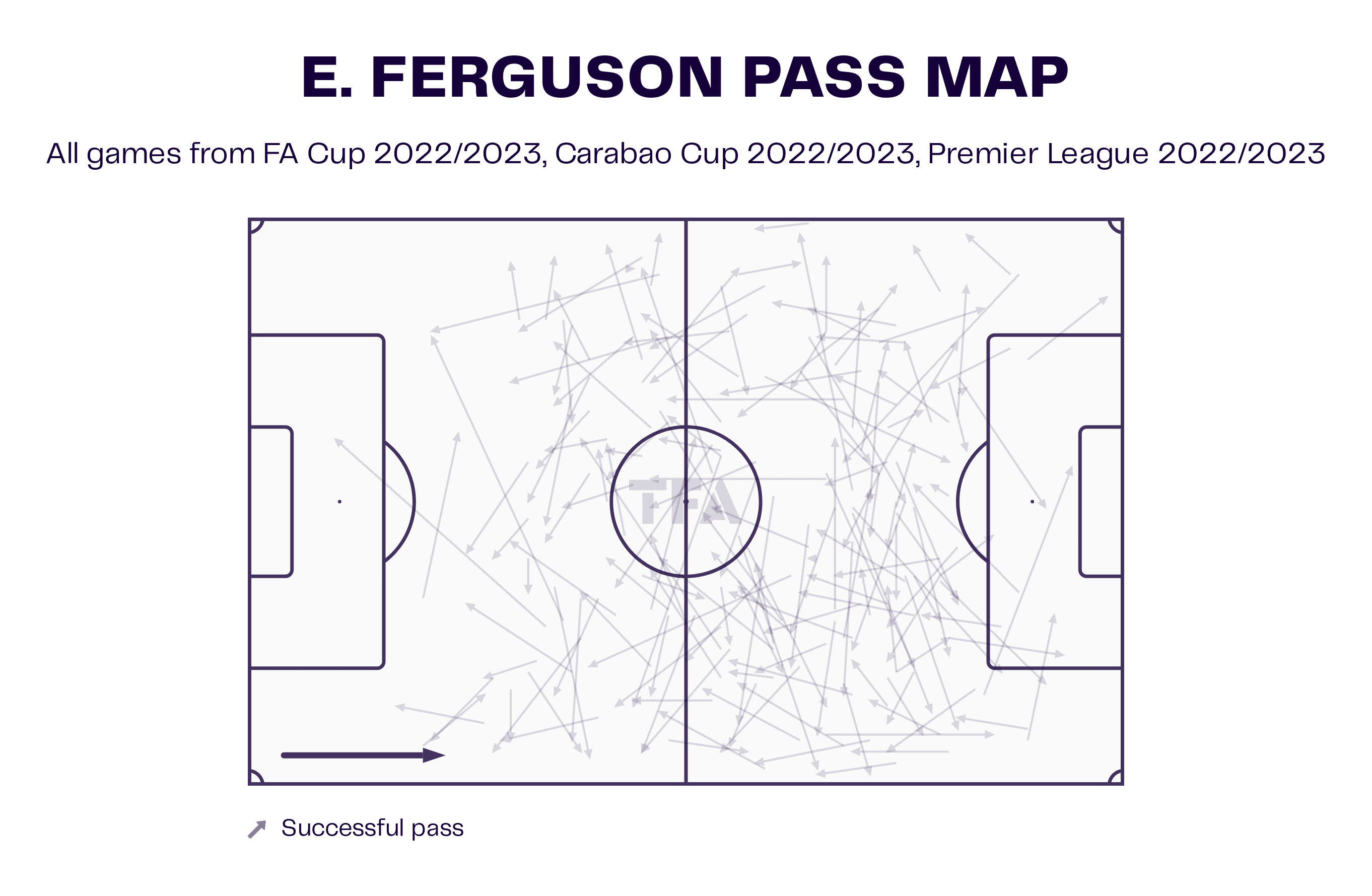
If we look at Wyscout data, we can see that Ferguson averages a pass accuracy rating of 85.1% from his 12 Premier League games to date.
If we look at the pass map above, we can ascertain that the former Bohemians man plays a significant number of passes to fellow attacking players in wider areas.
The Brighton players look to Ferguson somewhat as a target man to hold the ball up and then either spread the play wider or use vertical passes to maintain possession and play through the lines.
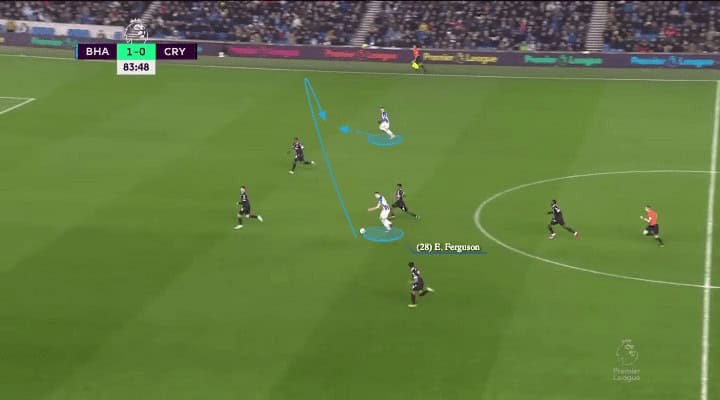
Here, in Figure 3.1 which is a continuation of Figure 2.1, we can see that Ferguson has travelled up the pitch.
It’s late in the game, and Brighton are 1-0 up, arguably, it would have been easier to charge for the corner flag or simply just keep running and eventually draw a Palace player into committing a foul.
Evan Ferguson opts for probably the most difficult thing to do in this situation and makes it look easy.
Whilst running with the ball, the Irish forward realises he is soon going to be surrounded by several players wearing Palace shirts.
So, without panic and without a second thought, he delicately chips the ball across to his teammate.
This wonderful pass is so accurate it lands right on the foot of his teammate and Brighton continues to progress into the attacking third.
Ferguson doesn’t stop there, he continues his run and makes himself available in the penalty area should a crossing opportunity occur.
A constant goal threat
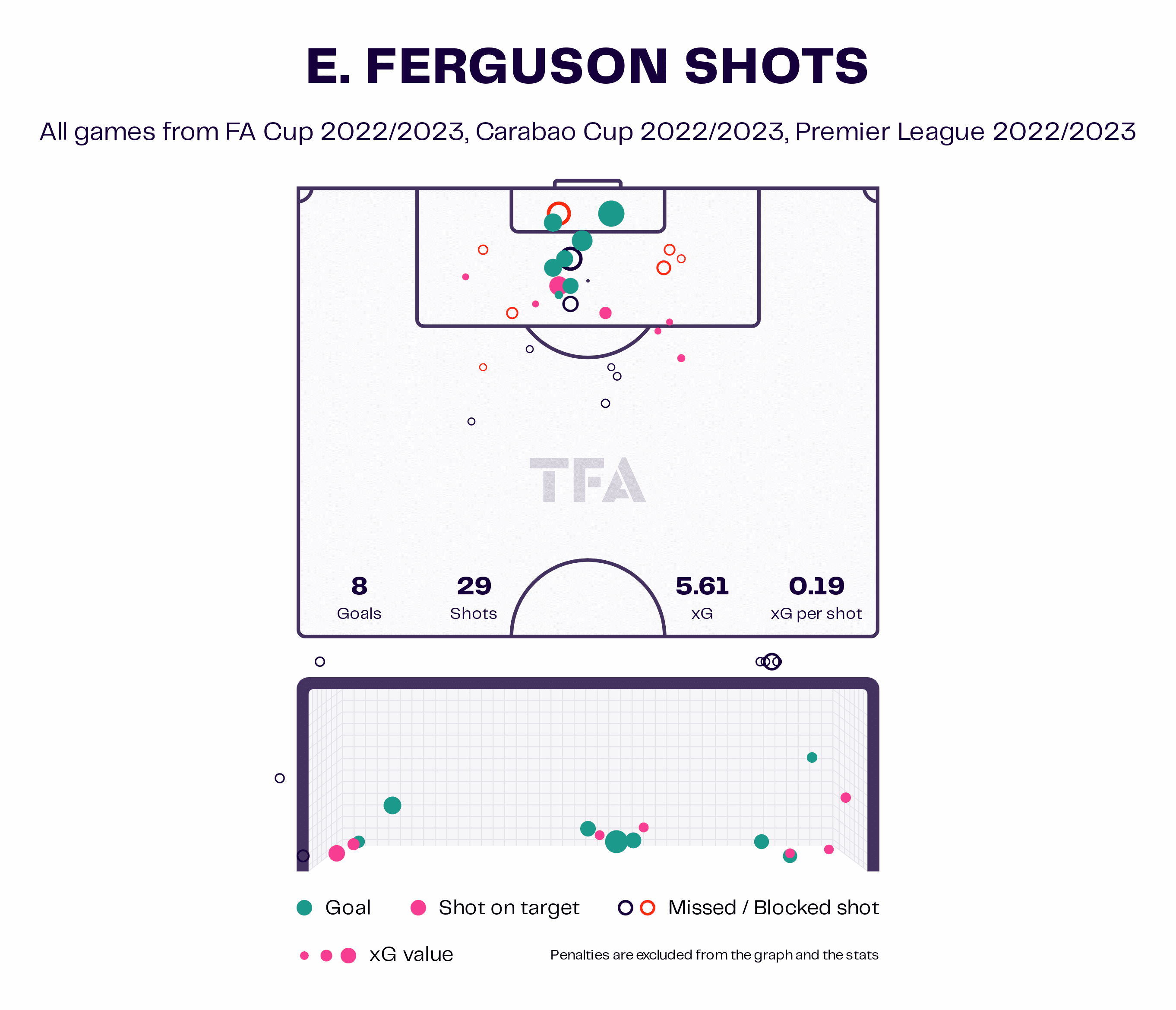
As we know, any centre forward worth their weight in gold needs to come up with the goods regularly, and by that we mean goals.
So far this season, the 18-year-old has chipped in with eight goals in all competitions which gives him an average of 0.7 goals per 90.
From the data viz, we can see that his goals have come from an xG of 5.61.
Whilst there is a lot of debate around the ‘expected goals’ metric and how it’s measured, we can work on the overall basis that Ferguson has scored some low percentage chances, meaning he is clinical when an opportunity presents itself.
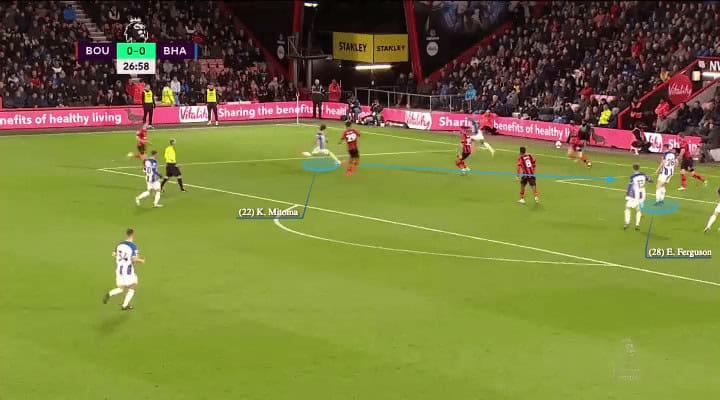
Ferguson scores a low percentage opportunity here in Figure 4.1 – Brighton are attacking and we can see that he is in the box waiting for the low cross to come in.
Mitoma fires the ball across and it’s a little behind Ferguson, does he take a touch and attempt to spin around to get a shot at goal? Absolutely not, such is the confidence of the young man, he nonchalantly backheels it into the bottom corner of the Bournemouth goal; 1-0 Brighton.
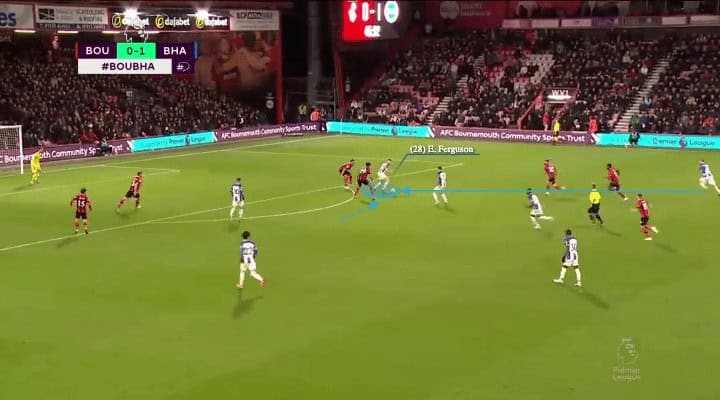
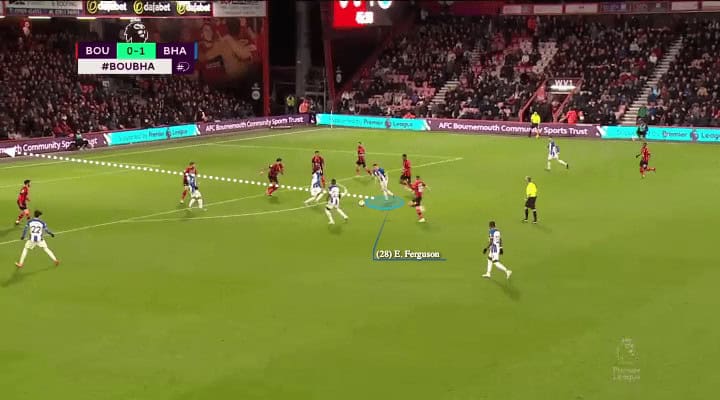
So, we know that Ferguson is a threat from inside the penalty area, but that’s not all, being an astute forward from close range isn’t all the young starlet is capable of.
This guy loves a shot from outside the box.
Zone 14 is his favourite place on the pitch, as we can see from Figure 4.2, Ferguson moves across a little to make himself available for a pass and then wrong-foots the defenders, thus creating enough space for him to launch a shot at goal.
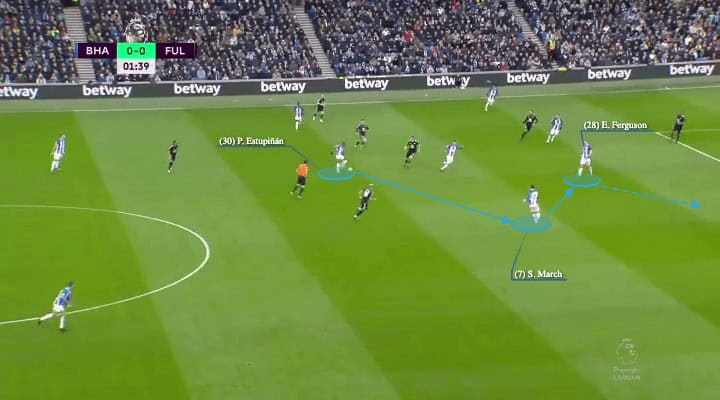
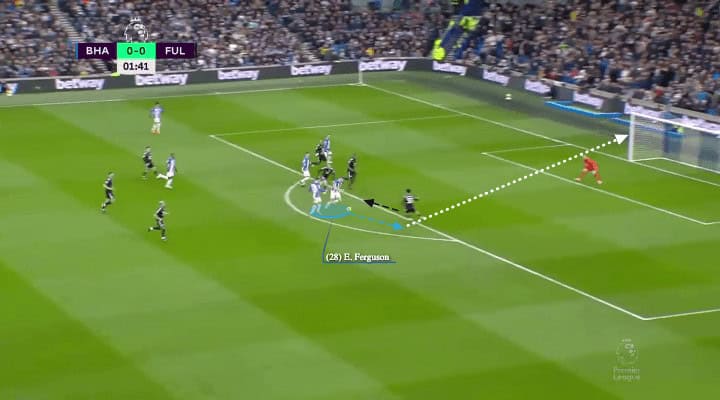
In this scenario, just over a minute into the game and we can see the Brighton build-up play through the lines, Estupiñán fires the ball forward to Solly March who executes a cute little flick into the path of Ferguson.
The young forward quickly brings the ball under control and uses his delightful close control to carve out an opening.
He allows the defender to commit himself and then evades the challenge and is able to fire a shot at Leno in the Fulham goal.
Off-the-ball movement
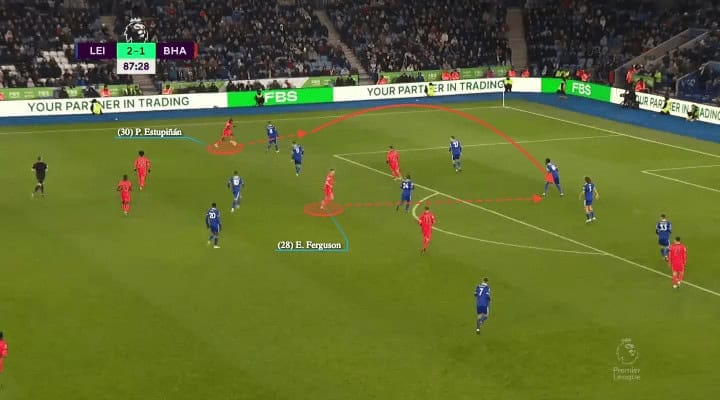
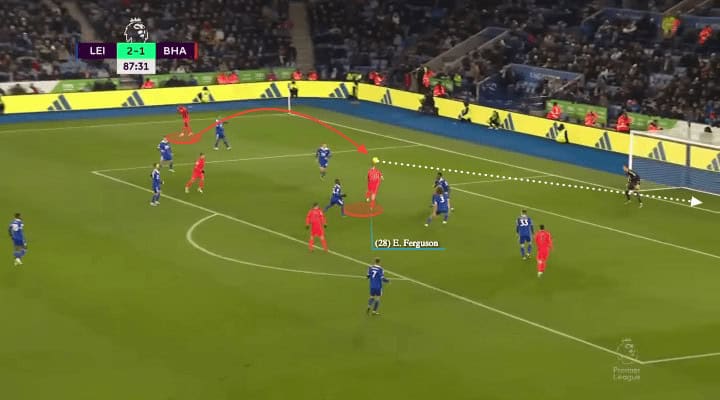
What makes Evan Ferguson such a goal threat is his excellent off-the-ball movement.
Here, in Figure 5.1, we can see this in full effect.
Whilst a less intelligent forward would already be in the penalty area, waiting for the cross to arrive, Ferguson realises that his best chance of scoring a goal from this scenario is the element of surprise.
Having dropped deeper to collect the ball and lay it off to Estupiñán, the Brighton forward holds his run, just ever so slightly.
Noticing the Leicester defence is preoccupied with anticipating when the cross will arrive, Ferguson breezes into the penalty area and leaps to connect with the ball as we can see in Figure 5.2.
He plants a beautiful glancing header in the far corner beyond the dive of goalkeeper Danny Ward.
The rumoured Newcastle target is incredibly mobile and he covers a vast amount of ground per game.
His positioning and off-the-ball movement are key reasons why clubs are taking notice of his performances for the Seagulls.
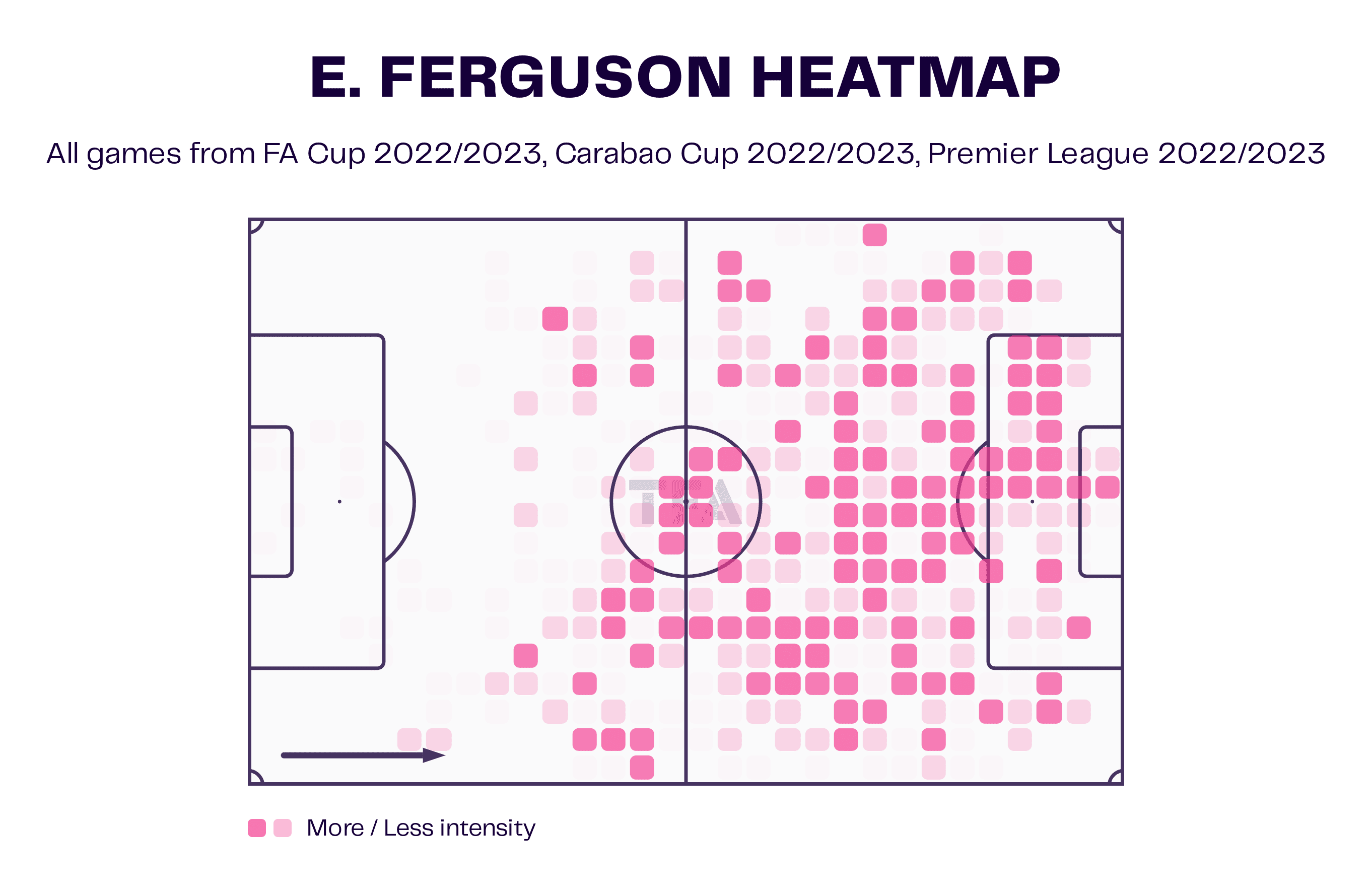
From the heatmap above, we can see that whilst he may share some traits of an ‘old-school’ number 9 with his striker’s instinct, Ferguson is straight out of the Harry Kane mould of what a good forward should be.
As we mentioned previously, he is incredibly active in zone 14 which means he is occupying the opposition’s defensive line and he also drops back into midfield areas often to provide an outlet for his teammates – this is ‘Act One’ in the Kane playbook of ‘How to be a Striker’.
Off-the-ball movement is a key skill for a centre forward.
It demonstrates their ability to not only understand the game but implement the manager’s tactical style.
By moving off the ball, a centre forward creates so much space which can be exploited in several ways, by dragging defenders away so teammates can attack said space.
This is especially useful when a team is looking to generate crosses into the box from wide areas.
Good off-the-ball movement can confuse defenders who may be tasked with marking him.
By constantly changing position, the centre forward can force the defenders to adjust their position, which can create plenty of opportunities for the centre forward or other attacking players.
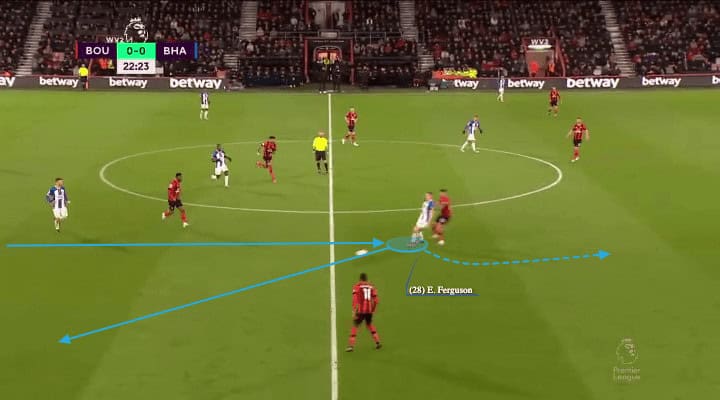
We can see here, how the youngster looks to drop deeper to offer a passing outlet for his teammates.
He receives a vertical pass and plays another vertical pass back to another colleague.
Ferguson then looks to spin his man and make a run in behind the Bournemouth defensive line.
This means that he is available should Brighton look to play a pass over the top.
This ultra-quick transition is a way of catching opponents off guard as they are expecting a measured build-up play through the lines.
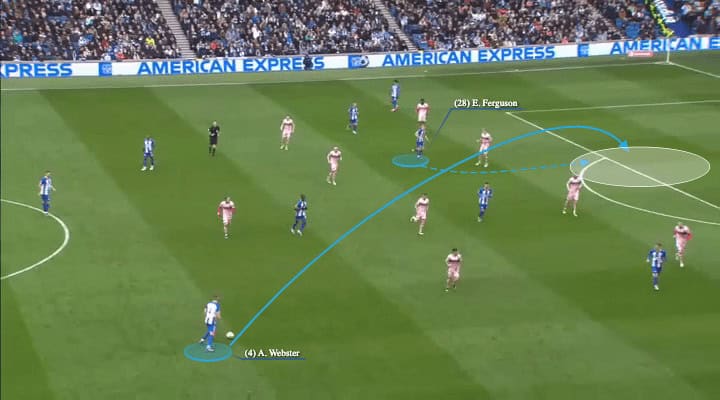
In this final example of Ferguson’s off-the-ball movement, figure 5.4 demonstrates how the sought-after forward uses arching runs to stay onside and ensure that he gets goalside of the defender.
Ferguson sees Webster as he looks to play the ball over the top and makes a darting run that takes him past the defender and into the space behind the defensive line who are set up in their traditional block of four.
His ability to do this so effectively means that Brighton has a myriad of options when it comes to building an attack.
His versatility is their biggest asset, hence why De Zerbi is so keen to keep hold of the 18-year-old and why he has had no second thoughts about throwing him in at the deep end since Trossard’s January exit.
Communication skills
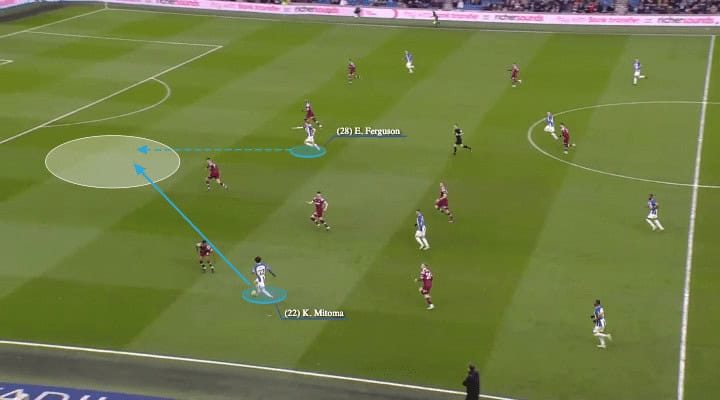
The psychological aspects of Ferguson’s game are often visible, he is an excellent communicator with his Brighton teammate.
Completely unphased by the stature of those around him, he makes it so easy for his colleagues to play a pass, exactly where he wants.
We can see in Figure 6.1, Mitoma has the ball and is scanning where he should play the next pass in this sequence.
Meanwhile, the Irishman points to the exact area he demands Mitoma play a deft pass and the attack continues.
This is a great display of communication and confidence.
He does not shy away from taking responsibility for himself on the pitch ensuring he and his teammates are on the same page which makes for a much more cohesive unit in both attack and defence.
Possible destinations for Evan Ferguson
We mentioned earlier in this scout report that it is highly likely that Ferguson will have many suitors chasing his signature in the summer.
Therefore, we thought it only right that we highlight some of the potential candidates.
Given that Ferguson has already established himself as a Premier League striker, it is unlikely that a team such as Borussia Dortmund would make a move for him due to the price tag Brighton will attach to their young talisman.
A more viable option then, is a move to another Premier League club, here are three possible options:
Newcastle United
As mentioned earlier in this scout report, it is very well documented that Newcastle United are frequently deploying scouts to track Ferguson’s progress.
Despite their newfound wealth, it has to be said that The Magpiesa recruitment strategy is still rather cautious.
Each signing is well thought out and there are plenty of scouting missions and data analysis before any contact is made.
With Eddie Howe’s men on the charge for Champions League football, they are looking at attacking options to bolster their forward line.
Given that the club spent a vast amount to bring Swedish striker Alexander Isak to the club, their interest in the Irishman is likely to be an indictment that Howe doesn’t necessarily see Callum Wilson as a good enough alternative or strike partner for the Swede.
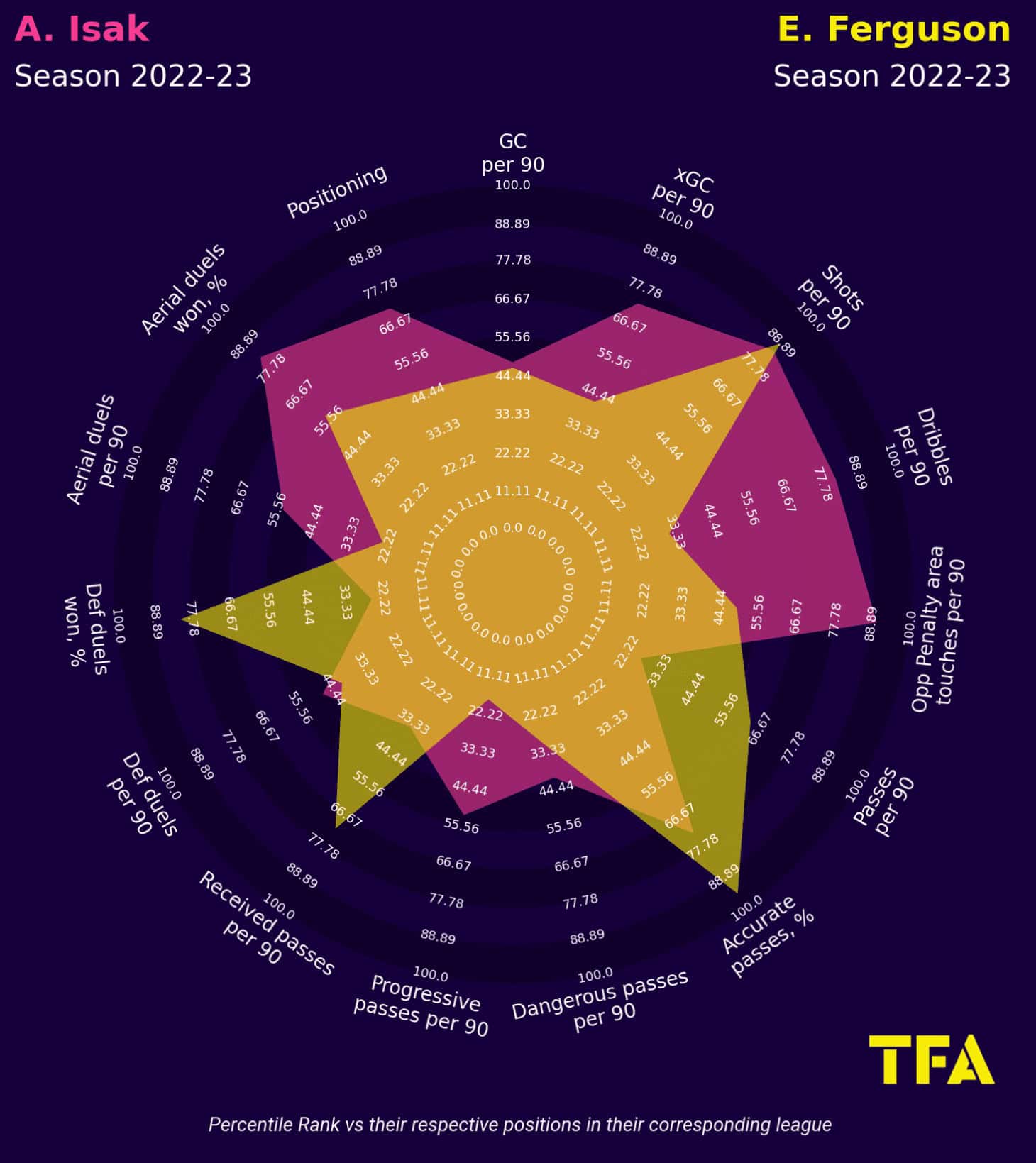
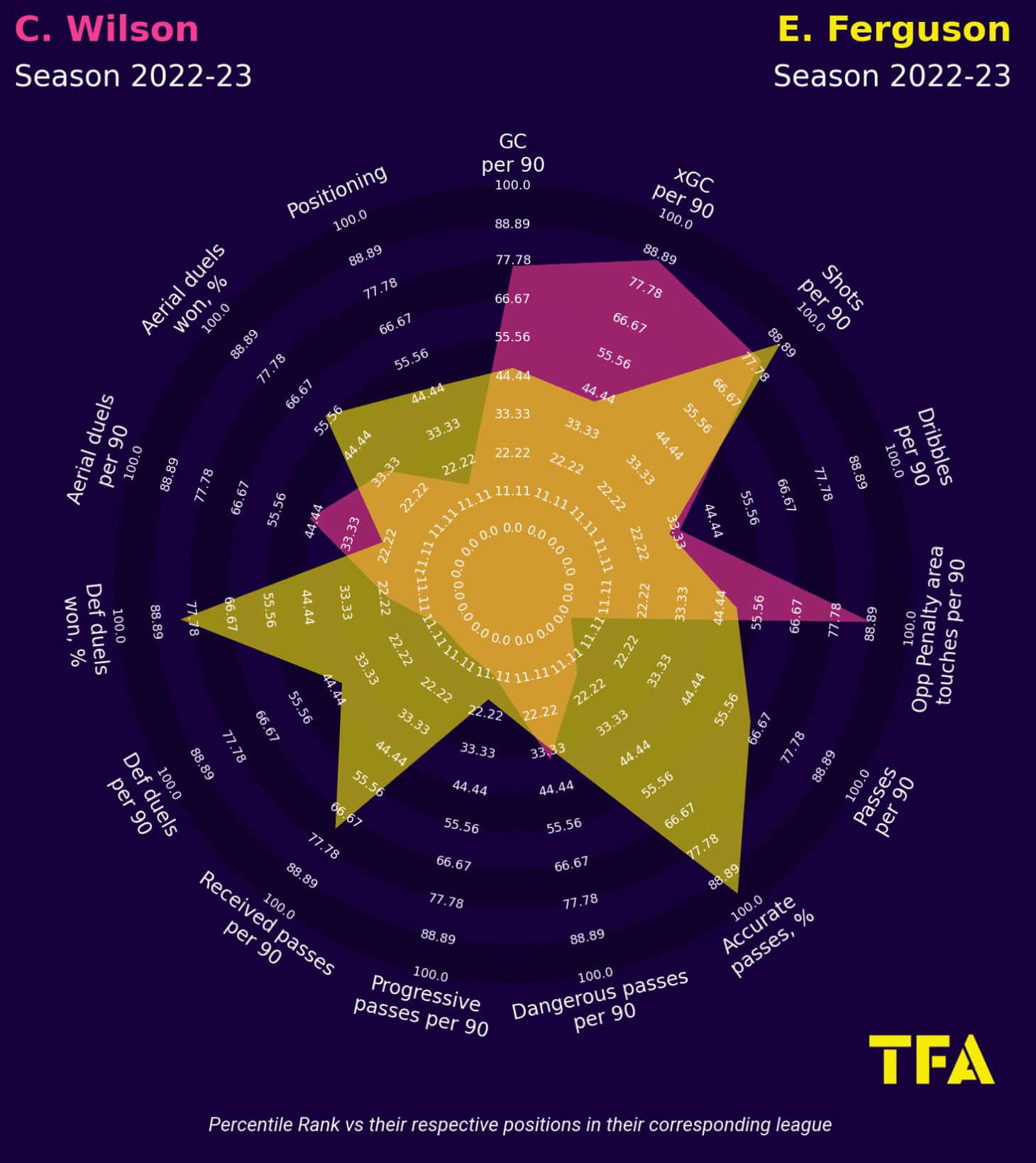
If we compare Ferguson to both the Magpies front men, we can see that he and Isak share some similar qualities.
They both are willing to work for the team and battle in the defensive duels.
Equally, they both have that natural striker’s instinct and will always look to get a shot away.
Both players have similar goal contributions per 90 although the Swede is underperforming his number of expected contributions.
Ferguson is more of a passer of the ball which is in line with him being utilised as a link-up man at Brighton.
It is easy to see why Eddie Howe might think these two could complement each other well on the pitch.
Additionally, if we compare Ferguson to Wilson, we can see that the Brighton man receives many more passes than the former Bournemouth player.
His signing would provide Newcastle with the opportunity to play into his feet and have him hold the ball up or distribute it to the wide areas for the likes of Almirón or Saint-Maximin.
Wilson is still a clinical goalscorer even though his career is repeatedly blighted by injuries, but there is no reason to think that Ferguson could not potentially contribute with a vast number of goals should he sign for Newcastle.
Manchester United
It’s no secret that Manchester United and Erik ten Hag have been searching for a forward.
The emergency acquisition of Wout Weghorst in January is purely a stop-gap until the summer when some big decisions are going to be made.
It’s widely accepted that ten Hag brought Weghoust to Old Trafford to act as a link-up man with wide players such as Marcus Rashford and Jadon Sancho.
We have established that this is something that Evan Ferguson is more than capable of doing.
The issue with Weghorst is his lack of goals with 0.12 per 90, so it’s unsurprising why he is only a short-term fix.
Goals, though, are something that Ferguson can provide, therefore he could be seen as an upgrade.
Moreover, at 18 years old, Manchester United would have a forward they could build around for many years to come which would mean a great level of stability for the club.
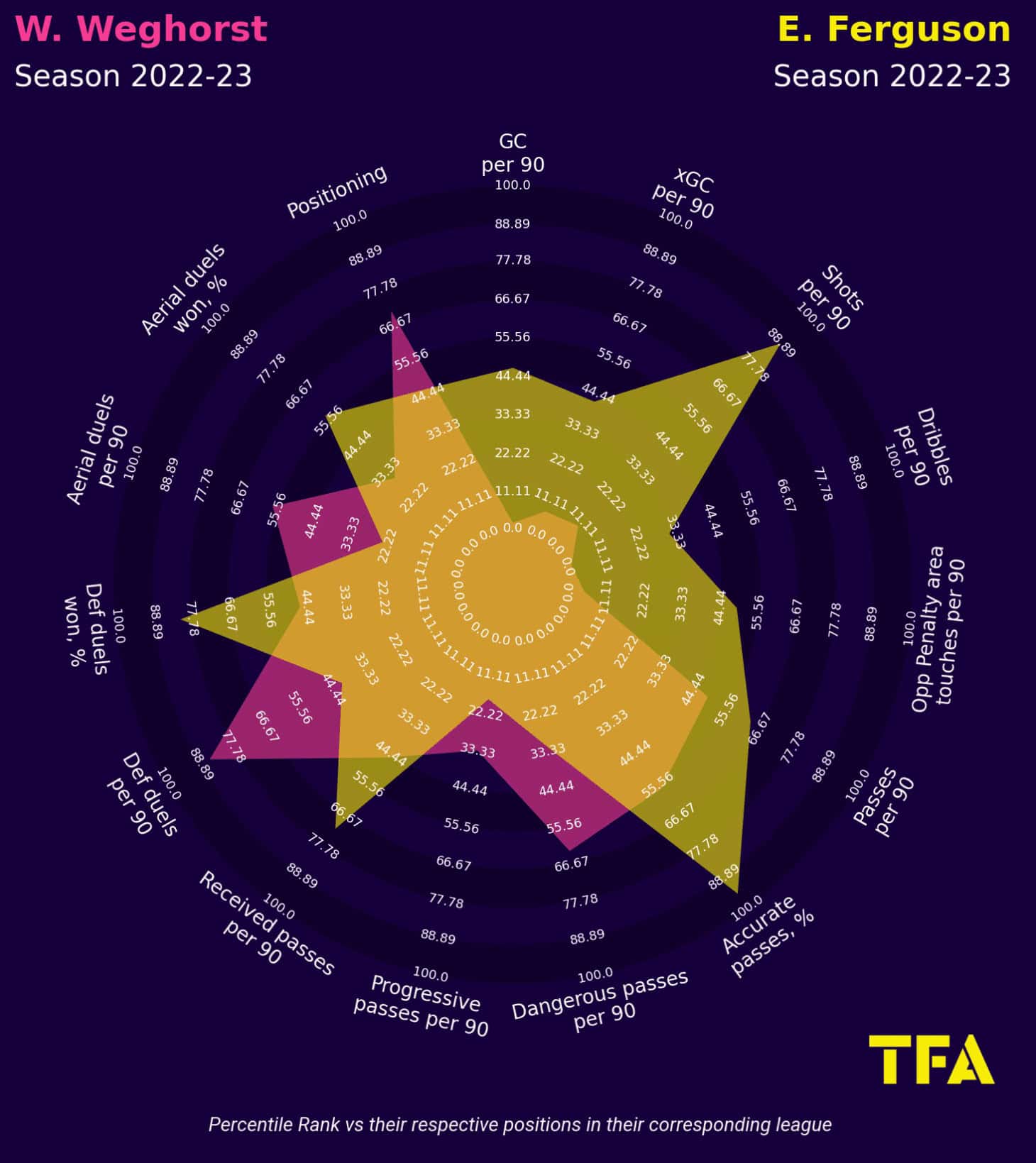
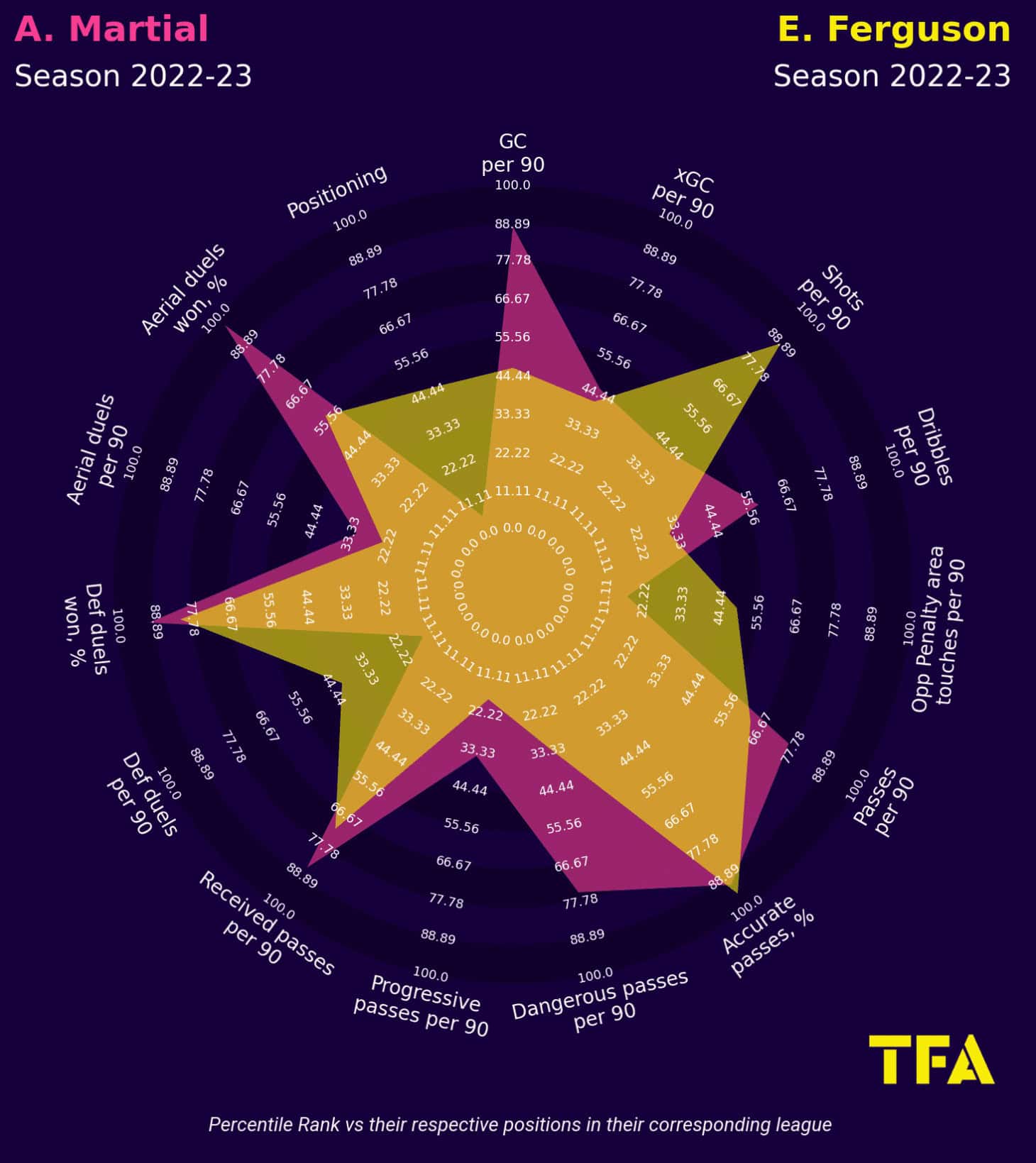
If we compare Ferguson to Anthony Martial, we can see that there are a few similarities in their styles.
Both players are reliable when passing the ball and are willing to enter into defensive duels.
Interestingly, Ferguson takes many more shots per 90, yet Martial has a higher number of goal contributions per 90.
Martial and Ferguson could be an interesting duo for Manchester United, whilst they are alike in many ways, they also bring different attributes to the table.
However, the Red Devils are possibly going to prioritise a move for tried and tested Harry Kane as they chase more immediate success, rather than looking to invest in a talented player for the future.
Tottenham Hotspur
Finally, if Kane decides he does want to make the move up North, Tottenham will be in the market for a new number 9.
Perhaps the Irishman could be a viable replacement.
Whether Daniel Levy would want to meet a likely rather large asking price is debatable.
However, in terms of footballing ability, Ferguson has plenty of wonderful traits that could be useful to the North London club.
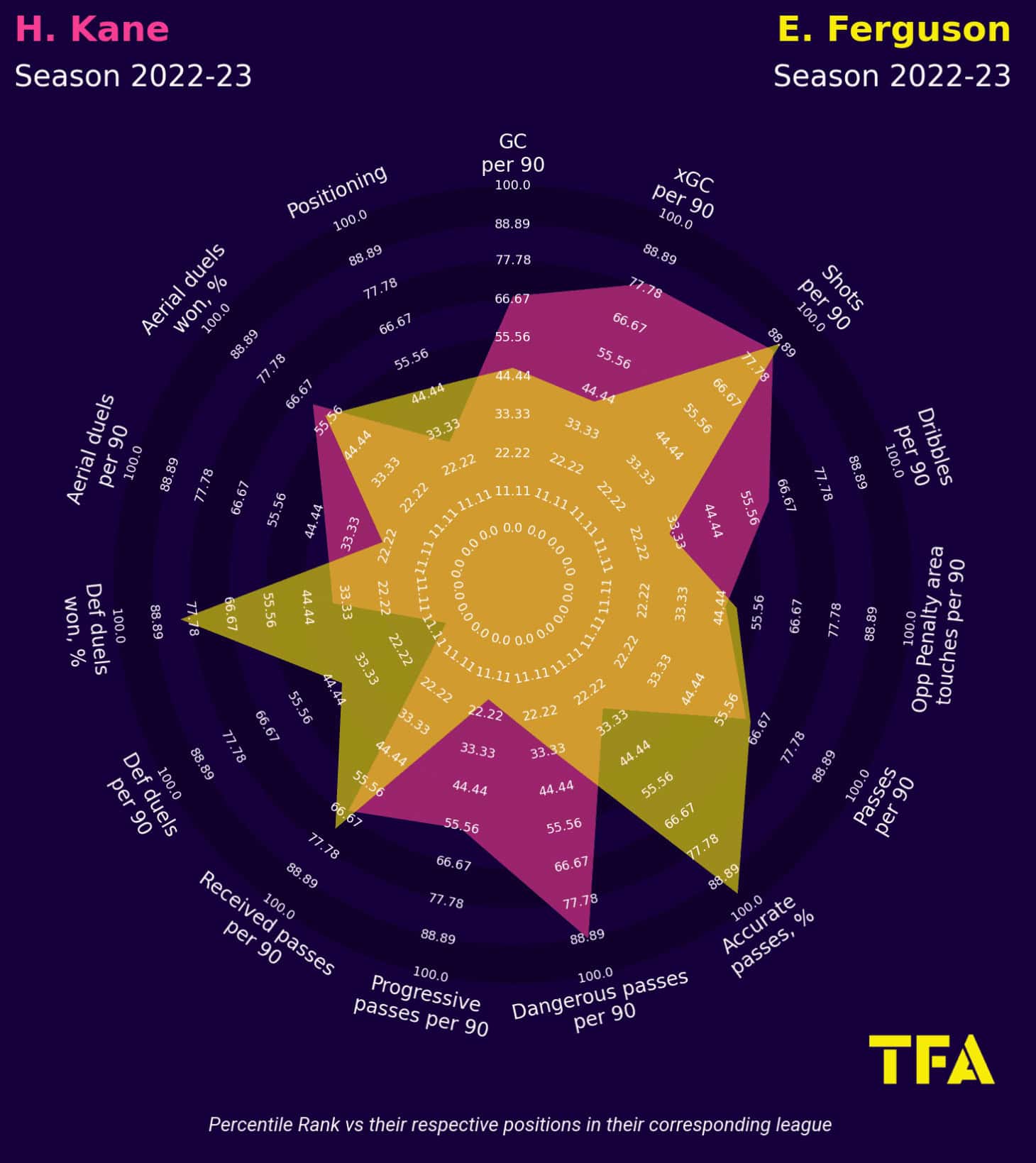
The two are not dissimilar, of course.
Harry Kane is a much more reliable goalscorer but he is significantly more experienced than the young Brighton man.
We have already established that Ferguson shares similar off-the-ball movement to Kane which means the Spurs players wouldn’t have to adjust their style too much on the pitch, in terms of finding their goal scorer with through passes.
The main stumbling block is that Tottenham are in a state of limbo.
With no new manager on the horizon, it is almost impossible to assess what their tactical set-up next season will be.
Equally, Evan Ferguson is a youngster with bags of talent so he is more than likely going to be able to adapt his playing style to suit another manager’s game model.
Conclusion
The time has come for us to wrap up this scout report.
We’ve dissected all the elements that make up Evan Ferguson’s game.
His talent is undeniable, it always has been, ever since he took to the field as a 14-year-old against Chelsea.
Whilst there will be a few Premier League clubs chasing his signature in the summer, Brighton are going to fight to keep one of their most talented youngsters.
With the Seagulls surprising many and being in contention for European football, it’s not unthinkable that he will stay at the Amex for another season.
In all honesty, wherever Evan Ferguson plays his football next season, he will continue to shine because this 18-year-old is only going to get better





Comments